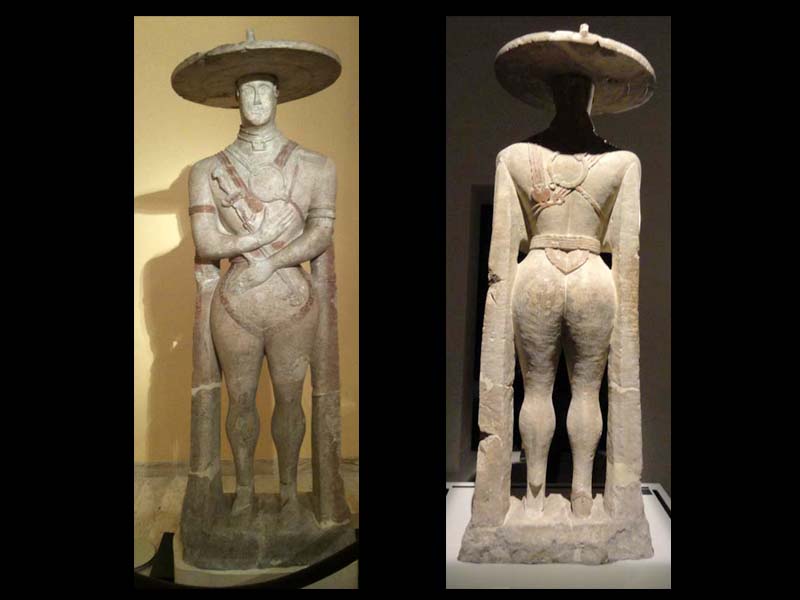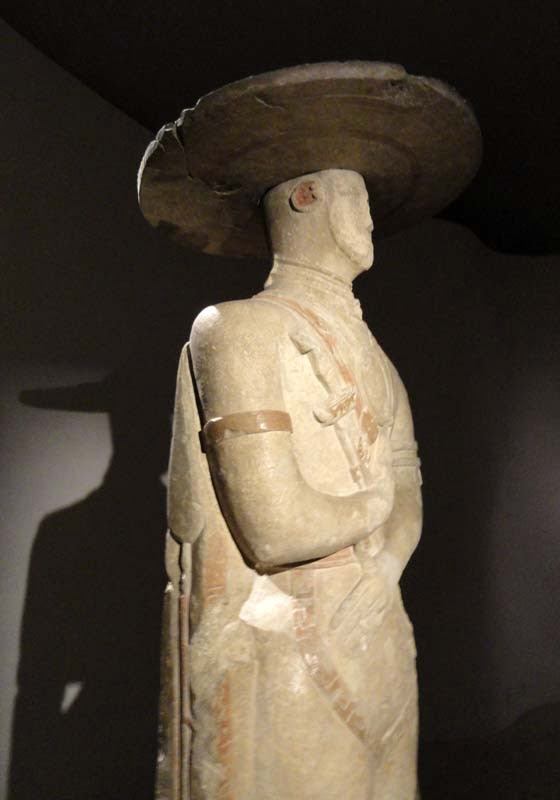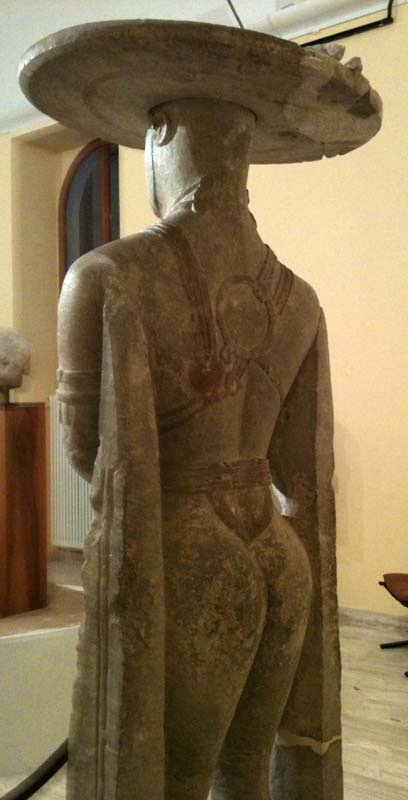di Kristina Berggren
In 1934, it fell to a farmer working on his land just outside the town of Capestrano to find a large statue. The front was badly worn, but the back was in perfect condition. It was broken below the knees but the base with the legs was found a short distance away and the helmet still further away.
Capestrano was a very small village on an acropolis, which had its own cemetery (the place where the warrior was found) with only 33 graves. It was a village made up of huts, the water had to be fetched far away, they had sheep, perhaps cows, it was a very hard life and we know from the anthropological studies on the bones of this time that the women did not reach more than 25 years of age, the men maybe a little more, but not much. They were poor, but they had artists who did stupendous things: in Abruzzo we found fibulas like you only see in Central Europe.
But let's go back to the statue, which is one of the marvels of archaic art. It is large (even without the helmet and the base it measures 1,71 m. in height), made of limestone on which traces of red ocher still resist and represents a warrior who stands with his feet firmly planted on a rectangular base between two pillars that reach up to his armpits. A spear is engraved on the outside of each pillar. On the front side of the right pillar there is a vertical inscription: Giuseppe Moretti, then Superintendent of Lazio and Rome, read it from bottom to top, twenty years later, Gerhard Radke read it from top to bottom.
The head is covered by a hemispherical helmet with a very wide brim, once surmounted by a crest. The underside of the brim is decorated with three concentric circles. A mask, which leaves the eyes and mouth uncovered, covers the face. The ears have a spiral shape and are painted red. Around the neck is a triple necklace which also terminates in a spiral and bears what was probably a square amulet on the front. On the chest and back are two rings to which straps are knotted holding a sword on the right side and a hatchet on the left. On the right arm there is a smooth bracelet, on the left two. The right hand is placed under the right breast, the thumb pointing upwards to form a triangular space, which repeats the triangle formed by the straps under the neck. The wrist rests on the sword, the index finger rests on the handle of the hatchet. The left hand rests in a similar position on the right stomach, the wrist rests on the lower part of the sword, the thumb on the wide belt. A band decorated with meanders follows the curve of the hips ending in the center of female genitalia. On the back, just above the buttocks, the band (with two rows of zigzags) starting from the waist describes another triangular shape. The sandal on the right is the original one, the one on the left has been reconstructed.
In 1939, Axel Boethius following Moretti's reading of the inscription, from bottom to top, proposed that the statue was that of a famous warrior. Later, Silvio Ferri and Louise Holland, reading the inscription from top to bottom according to Randke, suggested that the warrior had sacrificed himself as devotedto lead his team to victory.
I have several objections to both interpretations. A warrior statue should wear suitable armor. While the straps he wears have not been found on any other statue or tomb. To settle the question, Moretti, under the impression produced by the discs found at Aufidena, describes the rings on the chest and between the shoulder blades as cardiophylakes, discs used to protect the heart. Louise Holland, Valerio Cianfarani and automatically all the others from that moment followed his indication. However, Aufidena's discs are twice the size and looking closely it becomes clear that iconographically these are rings and not discs.
Another objection: if the statue belongs to a great warrior, a prince, a statue in honor of someone, why was it placed in a cemetery instead of in the village? And if it was placed on a grave, why was no princely grave found? If it was in memory of one devoted, why here and not on the battlefield? However, the most important objection is that all male statues have the male genitalia prominently displayed and that the short vertical slit at the end of the statue's abdomen can only indicate the female sex. The idea that the statue represents a warrior would make it the only statue in the world where the male organ is replaced by a female one. I was told that since the statue has no breasts it means it is a man, as if the breasts alone were an indisputable indication. The two small bronze statues from Novilara show how illogical this statement is. They have no breasts, but female genitals and hold hands in the same way as a warrior, yet it never occurred to anyone to doubt their femininity. That the warrior is a woman is beyond dispute for me, but the question is rather who she represents and why a statue of a female warrior was erected in an archaic cemetery.
Twenty years ago I began to have doubts about the possibility of interpreting the enigmas of prehistoric art on the basis of conventional theories, whereas perhaps it is possible to do so using CG Jung's technique and his definition of symbols. As a result of these doubts of mine, I obtained a degree in Analytical Psychology and it is as a psychologist rather than an archaeologist that I now speak.
According to Jung, a symbol is never a sign or an allegory, but the best possible expression of something that escapes any explanation or description; of something that can only be explained through analogies with our physical universe. The Warrior is not a portrait but a symbol, the expression of something too big, too hidden from our sight to sum it up in a few words, and all the details (the helmet, the mask, the ocher colour, the ”, the shape of the body, the pillars) are also symbols. And that all together are the key that allows us to arrive at her identity.
Let's start with the mask. The literature in this regard is vast and I just want to underline that the mask is not only used for a game of dissimulation, but that outside modern society it has always had and still has a religious function. The masks are sacred and when you wear the goddess, the god is among us. We cannot look directly at a goddess or a god. Zeus visited the women he fell in love with not only with the mask lowered over his face, but also in the guise of an animal, a swan, a bull. The artist has placed a mask on the face of the Warrior of Capestrano to indicate that she did not want to make a portrait but a symbolic representation of someone whose face we mortals cannot see. The mask that covers the Warrior's face shows us that the statue represents a goddess.
Even the traces of red ocher are symbolic. Red is the color of blood. We women are intimately associated with it. We bleed every month; we lose a lot of blood when we give birth. Considering how intimately blood is associated with giving birth, it is not difficult to see why it has come to symbolize life, both the life force within every living creature and the life-giving power of deities. When someone is painted red, he represents the Other, in the same way as when he wears a mask that symbolizes a deity. A red painted sculpture is either that of a deity or someone dressed as a goddess or god.
The large circle on the Warrior's chest is the first circle we see. Only by approaching and observing carefully do we notice the three concentric circles under the brim and how the sculptor placed the statue in their centre. The straps serve to reinforce the symbolism of the circle. They draw three Vs on the back and four in front. The Vs not only remind us of the centrality of the circle and where the Goddess stands, but they take the viewer one step further. Marija Gimbutas has shown that the sign V belongs to the goddess symbolized as a water bird and one of the statuettes from Vinca of the sixth millennium allows us to identify it. It's a goose. The bird, however, is rarely represented naturalistically, for that would make it a portrait, not a symbol, and although the goddess can do what humans cannot, the goddess is not a bird; the bird is an analogy.
What does the bird represent? Ethologist Konrad Lorenz, after observing geese throughout his life, considered the gray goose to be the most intelligent of animals and most closely related to humans. At the time of the Warrior, the goose was the most widespread figure in all of Europe. The gray goose symbolizes the land it lives on, the water where it loves to swim, the air where it flies. In the same way that, until recently, storks carried babies to the cradle, the goose brought fertility to the mother. It's not hard to see why wild geese offer a good symbolic explanation. As migratory birds, wild geese present an analogy to the ever-changing moon. In a lunar month, the moon goes through four phases and each month hides for three nights, the period of the "black" moon, of the dying moon. Thus the moon dies and is born every month without fail and this rhythmic alternation that never stops provides an analogy between the moon and the geese. As the moon returns after three nights of absence and the geese return after winter, so life and fertility will return after the black night of winter and death. As if to confirm this theory, the geese fly in a V formation, drawing the regenerative sign of the goddess in the sky.
The belt is another symbol of fertility, the symbol of sexual intercourse with all its associations. Simple belts such as the one worn by the Warrior are common in tombs from this period, belts that have taken the place of earlier ones, which were much more elaborate often engraved with stylized geese. In the fourteenth book ofIliad, Hera borrows the belt of Aphrodite, the goddess of sexual love, to seduce Zeus and for a while changes the course of the Trojan War. In my opinion, this is one of the symbolic meanings of this Warrior belt, but there is also a different purpose. She divides the statue into two parts: the upper one, a masculine body with a remarkably strong neck and broad shoulders, and the lower one with a rounded abdomen, with rounded hips and buttocks. The sculptor has carved an androgynous Warrior. He may sound shocking to some, but we must always think that we are dealing with a symbol of divinity.
The androgynous nature of the Warrior explains the sword hanging diagonally from the male right shoulder to the female left hip, covered but not supported by the wrists, so that the arms form a cross, with the Female Warrior at the center. A Warrior uses the sword to kill, what association can he have with a Female Warrior?
In ancient Greece she was called Lachesi, in central Europe Skuld: she was the third spinner who cuts the thread of life. Athena also does it, called Minerva in Italy: she is the goddess of war, not of the blind fury of war but of intelligent struggle, and her armor and shield are by no means her accessories. She and she not only carries the sword, but also a male spear (remember the spears on the outer side of the pillars?). However, she is also a lunar goddess, as indicated by the crescent of a new moon often placed over her head on Athenian coins. The Warrior kills, but she also protects the dead in her earthen womb. Like the moon, the androgynous jar transformed cremated bones.
The Warrior placed in the cemetery was therefore the symbol of the hope that death was not the end but a new beginning. She stands on a threshold, formed by the base of the two pillars. In fairy tales, the weaver often stands in the doorway spinning the thread of life. The threshold is the space between, neither inside nor outside, where we arrive by dying. The Warrior is there to welcome us. She is male and female. She has her face covered by a mask to remind us that we cannot look her in the face. She is the Life in Death like the red color of the blood associated with every violent birth or death. It is the goose that returns in spring and leaves again in autumn. It is the moon that is reborn. He is the center of her children's lives.
What an incredible treasure the ancient cemetery of Capestrano has given us – what a magnificent statue it has been found in the heart of the Abruzzo region!
Kristina Berggren
Kristina Berggren, Swedish archaeologist, has lived in Italy for more than 20 years. You have been a member of the Swedish Institute of Classical Studies in Rome and have dealt in particular with the Etruscans and other pre-Roman Italic civilizations. She specialized in Mythology at the Pacifica Graduate Institute in California with a thesis on the prehistoric Symbols of transformation, she gave the Capestrano "warrior" an interpretation that radically changes the meaning accredited up to now.
The article reported here is the synthesis of his speech in Pescara during the cycle of meetings "In the Footsteps of the Great Mother" organized by the Margaret Fuller Women's Culture Center at the Literary Café of the Museo delle Genti between January and June 2005.
His thesis, which is based on comparisons with androgynous figures present in cultures of various parts of the world, is exposed in a more articulated way in From the Realm of the Ancestors. An Anthology in Honor of Marija Gimbutas, edited by Joan Marler, Knowledge Ideas & Trends, 1998.




